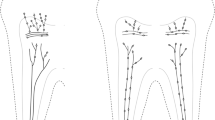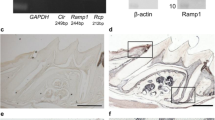Abstract
The distribution of the tachykinin receptors neurokinin-1 (NK1), neurokinin-2 (NK2) and neurokinin-3 (NK3), and the calcitonin gene-related peptide-1 (CGRP1) receptor were examined in rat teeth and tooth-supporting tissues by immunohistochemical methods and light and confocal microscopy. Western blot analysis was performed to identify the NK1- and the CGRP1-receptor proteins in the dental pulp. The results showed that odontoblasts and ameloblasts, cementoblasts and cementocytes, osteoblasts and osteocytes are all supported with the tachykinin receptors NK1 and NK2, but a distinct, graded cellular labeling pattern was demonstrated. The ameloblasts were also positive for CGRP1 receptor. Blood vessels in oral tissues expressed the tachykinin receptors NK1, NK2 and NK3, and the CGRP1 receptor. Both gingival and Malassez epithelium were abundantly supplied by NK2 receptor. Pulpal and periodontal fibroblasts demonstrated NK1 and NK2 receptors. Western blot analysis identified both the NK1- and the CGRP1-receptor proteins in the dental pulp. These results clearly indicate that the neuropeptides substance P, neurokinin A, neurokinin B and CGRP, released from sensory axons upon stimulation, directly modulate the function of the different types of bone and dental hard tissue cells, and regulate functions of blood vessels, fibroblasts and epithelial cells in oral tissues.




Similar content being viewed by others
References
Berggreen E, Heyeraas KJ (2000) Effect of the sensory neuropeptide antagonists h-CGRP((8–37)) and SR 140.33 on pulpal and gingival blood flow in ferrets. Arch Oral Biol 45:537–542
Berggreen E, Sae-Lim V, Bletsa A, Heyeraas KJ (2001) Effect of denervation on healing after tooth replantation in the ferret. Acta Odontol Scand 385:379–385
Bernard GW, Shih C (1990) The osteogenic stimulating effect of neuroactive calcitonin gene-related peptide. Peptides 11:625–632
Bjurholm A, Kreicbergs A, Schultzberg M, Lerner UH (1992) Neuroendocrine regulation of cyclic AMP formation in osteoblastic cell lines (UMR-106-01, ROS 17/2.8, MC3T3-E1, and Saos-2) and primary bone cells. J Bone Miner Res 7:1011–1019
Bongenhielm U, Haegerstrand A, Theodorsson E, Fried K (1995) Effects of neuropeptides on growth of cultivated rat molar pulp fibroblasts. Regul Pept 60:91–98
Byers MR, Mecifi KB, Kimberly CL (1987) Numerous nerves with calcitonin gene-related peptide-like immunoreactivity innervate junctional epithelium of rats. Brain Res 419:311–314
Byers MR, Närhi MV, Mecifi KB (1988) Acute and chronic reactions of dental sensory nerve fibers to cavities and desiccation in rat molars. Anat Rec 221:872–883
Casasco A, Calligaro A, Casasco M, Springall DR, Polak JM, Poggi P, Marchetti C (1990) Peptidergic nerves in human dental pulp. Histochemistry 95:115–121
Dennis T, Fournier A, Cadieux A, Pomerleau F, Jolicoeur FB, St Pierre S, Quirion R (1990) hCGRP8–37, a calcitonin gene-related peptide antagonist revealing calcitonin gene-related peptide receptor heterogeneity in brain and periphery. J Pharmacol Exp Ther 254:123–128
D'Souza SM, MacIntyre I, Girgis SI, Mundy GR (1986) Human synthetic calcitonin gene-related peptide inhibits bone resorption in vitro. Endocrinology 119:58–61
Edvinsson L, Cantera L, Jansen-Olesen I, Uddman R (1997) Expression of calcitonin gene-related peptide1 receptor mRNA in human trigeminal ganglia and cerebral arteries. Neurosci Lett 229:209–211
Frank RM (1968) Attachment sites between the odontoblast process and the intradental nerve fiber. Arch Oral Biol 13:833–834
Fristad I, Heyeraas KJ, Kvinnsland I (1994) Nerve fibres and cells immunoreactive to neurochemical markers in developing rat molars and supporting tissues. Arch Oral Biol 39:633–646
Fristad I, Heyeraas KJ, Hals Kvinnsland I, Jonsson R (1995a) Recruitment of immunocompetent cells after dentinal injuries in innervated and denervated young rat molars: an immunohistochemical study. J Histochem Cytochem 43:871–879
Fristad I, Heyeraas KJ, Jonsson R, Hals Kvinnsland I (1995b) Effect of inferior alveolar nerve axotomy on immune cells and nerve fibres in young rat molars. Arch Oral Biol 40:1053–1062
Fristad I, Hals Kvinnsland I, Jonsson R, Heyeraas KJ (1997) Effect of intermittent long-lasting electrical tooth stimulation on pulpal blood flow and immunocompetent cells. A haemodynamic and immunohistochemical study in young rat molars. Exp Neurol 146:230–239
Gazelius B, Edwall B, Olgart L, Lundberg JM, Hökfelt T, Fischer JA (1987) Vasodilatory effects and coexistence of calcitonin gene-related peptide (CGRP) and substance P in sensory nerves of cat dental pulp. Acta Physiol Scand 130:33–40
Goto T, Kido MA, Yamaza T, Tanaka T (2001) Substance P and substance P receptors in bone and gingival tissues. Med Electron Microsc 34:77–85
Haegerstrand A, Dalsgaard C-J, Jonzon B, Larsson O, Nilsson J (1990) Calcitonin gene-related peptide stimulates proliferation of human endothelial cells. Proc Natl Acad Sci U S A 87:3299–3303
Hals Kvinnsland I, Tadokoro O, Heyeraas KJ, Kozawa Y, Vandevska-Radunovic V (2000) Neuroendocrine cells in Malassez epithelium and gingiva of the cat. Acta Odontol Scand 58:107–112
Heyeraas KJ, Berggreen E (1999) Interstitial fluid pressure in normal and inflamed pulp. Crit Rev Oral Biol Med 10:328–336
Hökfelt T, Broberger C, Xu ZQ, Sergeyev V, Ubink R, Diez M (2000) Neuropeptides—an overview. Neuropharmacology 39:1337–1356
Hubbard MJ (2000) Calcium transport across the dental enamel epithelium. Crit Rev Oral Biol Med 11:437–466
Jacobsen EB, Heyeraas KJ (1996) Effect of capsaicin treatment or inferior alveolar nerve resection on dentine formation and calcitonin gene-related peptide- and substance P-immunoreactive nerve fibres in rat molar pulp. Arch Oral Biol 41:1121–1131
Kido MA, Yamaza T, Goto T, Tanaka T (1999) Immunocytochemical localization of substance P neurokinin-1 receptors in rat gingival tissue. Cell Tissue Res 297:213–222
Lecci A, Giuliani S, Tramontana M, Carini F, Maggi CA (2000) Peripheral actions of tachykinins. Neuropeptides 34:303–313
Lerner UH (2000) The role of skeletal nerve fibres in bone metabolism. Endocrinologist 10:377–382
Lundberg P, Lundgren I, Mukohyama H, Lehenkari PP, Horton MA, Lerner UH (2001) Vasoactive intestinal peptide (VIP)/pituitary adenylate cyclase-activating peptide receptor subtypes in mouse calvarial osteoblasts: presence of VIP-2 receptors and differentiation-induced expression of VIP-1 receptors. Endocrinology 142:339–347
Luthman J, Luthman D, Hökfelt T (1992) Occurrence and distribution of different neurochemical markers in the human dental pulp. Arch Oral Biol 37:193–208
Mitsuhashi M, Payan DG (1987) The mitogenic effects of vasoactive neuropeptides on cultured smooth muscle cell lines. Life Sci 40:853–861
Morara S, Wimalawansa SJ, Rosina A (1998) Monoclonal antibodies reveal expression of the CGRP receptor in Purkinje cells, interneurons and astrocytes of rat cerebellar cortex. Neuroreport 9:3755–3759
Nilsson J, von Euler AM, Dalsgaard C-J (1985) Stimulation of connective tissue cell growth by substance P and substance K. Nature 315:61–63
Olgart L, Hökfelt T, Nilsson G, Pernow B (1977) Localization of substance P-like immunoreactivity in nerves in the tooth pulp. Pain 4:153–159
Olgart L, Matsuo M, Lindskog S, Edwall L (1995) Enhanced formation of secondary dentin in the absence of nerve supply to feline teeth. Eur J Oral Sci 103:160–165
Sherman BE, Chole RA (1995) A mechanism for sympathectomy-induced bone resorption in the middle ear. Otolaryngol Head Neck Surg 113:569–581
Tadokoro O, Maeda T, Heyeraas KJ, Vandevska-Radunovic V, Kozawa Y, Hals Kvinnsland I (2002) Merkel-like cells in Malassez epithelium in the periodontal ligament of cats: an immunohistochemical, confocal-laser scanning and immuno electronmicroscopic investigation. J Periodont Res 37:456–463
Togari A, Arai M, Mizutani S, Mizutani S, Koshihara Y, Nagatsu T (1997) Expression of mRNAs for neuropeptide receptors and beta-adrenergic receptors in human osteoblasts and human osteogenic sarcoma cells. Neurosci Lett 233:125–128
Tortorella C, Macchi C, Forneris M, Nussdorfer GG (2001) Calcitonin gene-related peptide (CGRP), acting via CGRP type 1 receptors, inhibits potassium-stimulated aldosterone secretion and enhances basal catecholamine secretion from rat adrenal gland. Int J Mol Med 8:261–264
Uddman R, Kato J, Lindgren P, Sundler F, Edvinsson L (1999) Expression of calcitonin gene-related peptide-1 receptor mRNA in human tooth pulp and trigeminal ganglion. Arch Oral Biol 44:1–6
Vandevska-Radunovic V, Kvinnsland S, Jonsson R (1999) Delayed recruitment of immunocompetent cells in denervated rat periodontal ligament following experimental tooth movement. J Dent Res 78:1214–1220
van Rossum D, Hanisch UK, Quirion R (1997) Neuroanatomical localization, pharmacological characterization and functions of CGRP, related peptides and their receptors. Neurosci Biobehav Rev 21:649–678
Wakisaka S, Nishikawa S, Ichikawa H, Matsuo S, Takano Y, Akai M (1985) The distribution and origin of substance P-like immunoreactivity in the rat molar pulp and periodontal tissues. Arch Oral Biol 30:813–818
Wakisaka S, Ichikawa H, Nishikawa S, Matsuo S, Takano Y, Akai M (1988) Neurokinin A-like immunoreactivity in feline dental pulp: its distribution, origin and coexistence with substance P-like immunoreactivity. Cell Tissue Res 251:565–569
Wimalawansa SJ (1996) Calcitonin gene-related peptide and its receptors: molecular genetics, physiology, pathophysiology, and therapeutic potentials. Endocr Rev 17:533–585
Wimalawansa SJ (1997) Amylin, calcitonin gene-related peptide, calcitonin, and adrenomedullin: a peptide superfamily. Crit Rev Neurobiol 11:167–239
Wimalawansa SJ, Gunasekera RD, Zhang F (1993) Isolation, purification, and characterization of calcitonin gene-related peptide receptor. Peptides 14:691–699
Ziche M, Morbidelli L, Pacini M, Dolara P, Maggi CA (1990) NK1-receptors mediate the proliferative response of human fibroblasts to tachykinins. Br J Pharmacol 100:11–14
Acknowledgements
We express our gratitude to S. Østvold and A. Nyhaug for technical expertise and assistance. The NK1-, NK2- and NK3-receptor antibodies were kindly provided by Dr. Nigel Bunnett, University of California, San Francisco.
Author information
Authors and Affiliations
Corresponding author
Additional information
Grants from the Norwegian Research Council (grant no. 129582) and the Dental Faculty, University of Bergen, Bergen, Norway, supported this study
Rights and permissions
About this article
Cite this article
Fristad, I., Vandevska-Radunovic, V., Fjeld, K. et al. NK1, NK2, NK3 and CGRP1 receptors identified in rat oral soft tissues, and in bone and dental hard tissue cells. Cell Tissue Res 311, 383–391 (2003). https://doi.org/10.1007/s00441-002-0691-z
Received:
Accepted:
Published:
Issue Date:
DOI: https://doi.org/10.1007/s00441-002-0691-z




